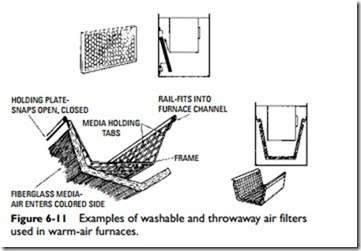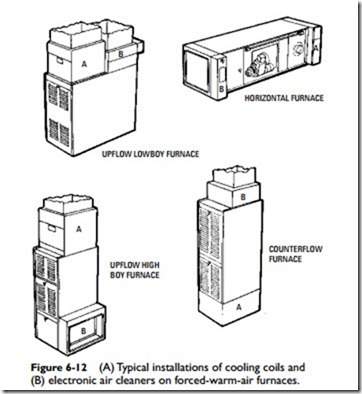Cooling with a Warm-Air Heating System
The simplest method of cooling a house in the summer is to use the blower of a forced-warm-air furnace. Most furnaces have a manual blower switch that can be used to circulate the air.
If you plan to install a central air conditioning system capable of maintaining comfortable indoor temperatures during the warmer months, you must first examine the existing furnace and duct sys- tem and determine what changes (if any) must be made to handle the cooling load.
Forced-warm-air furnaces can often be converted to year-round air conditioning by installing a cooling coil in the furnace supply duct and connecting it to a compact compressor-condenser unit located outdoors. The existing duct system may be inadequate for air conditioning, but this can be modified to handle the cool air by increasing the size of certain ducts or by installing additional ducts.
Some furnaces (particularly gravity warm-air furnaces) cannot be fitted with cooling coils, but the existing ductwork is adequately sized for cooling. If this should be the case, the furnace can be bypassed with the cooling coils and air handling equipment installed in a short length of duct that feeds into the main supply- and return-air ducts at a point near the furnace. Dampers must be placed in the ducts between the furnace and the cooling coil to pre- vent the warm and cool air from mixing.
If both the existing furnace and the existing ductwork cannot be used, it will be necessary to install a separate and independent air conditioning system. Adding one or more window units is the most common method of accomplishing this. Slightly more expensive is the use of a through-the-wall unit, which is installed by cutting a hole in the wall. The compressor-condenser section is located on the outside to reduce the noise level. Neither window units nor through-the-wall units use ductwork to distribute the cool air.
The most expensive separate and independent air conditioning systems are the single-package-unit systems and the very popular split systems. Both use ductwork to distribute the cool air. A single- package-unit system is limited to the installation of the cooling unit in the attic or basement, with the former location offering the fewest design problems. The advantage of a split system is that the cooling unit can be located anywhere inside the structure. In both systems, the preferred location of the compressor-condenser section is outdoors.
Air Cleaning
The air cleaning equipment used in forced-warm-air heating and cooling systems commonly takes the form of washable or disposable air filters or electronic air cleaners.
Washable and disposable air filters are installed in the return-air plenum of a forced-warm-air furnace as shown in Figure 6-11. These are dry filters consisting of cellulose fibers, steel wool, or some other suitable material set in a wire frame. These filters are effective only when dust concentrations are limited to 4 grains per 1000 ft3 of air or lower. Consequently, they are restricted in use to residences or small buildings. Air filters are not used in gravity warm-air heating systems because they impede the rate of air flow.
Electronic air filters are designed for return-air-duct installation at the furnace, air handler (in the duct), or air conditioning unit. They generally operate on the electrostatic precipitation principle and are capable of removing up to 95 percent of all airborne particles (e.g., dust, tobacco, and smoke). The dust particles are given an electric charge when they pass through an ionizing field and are collected when they subsequently pass between collector plates having an opposite charge. Typical installations are illustrated in Figure 6-12.
The various types of air filters and electronic air cleaners used in cleaning and filtering the air are described in Chapter 12 of Volume 3, “Air Cleaners and Filters.”

